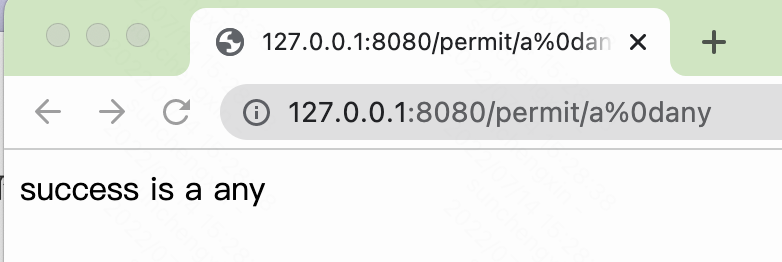正则匹配配置不当
前言
正则匹配如果被使用在权限检验的场景中,需要注意一些是否使用默认配置。如果使用默认配置会可能会导致被Bypass的情况,历史Java框架漏洞 Spring Security CVE-2022-22978,Apache Shiro CVE-2022-32532。
默认情况下的漏洞
示例代码,大多数开放很少注意到使用Pattern.DOTALL来避免匹配文本中的\r\n\t等字符,就很可能存在被绕过的风险。
Ps: Pattern内置了 CASE_INSENSITIVE、MULTILINE、DOTALL、UNICODE_CASE、CANON_EQ、UNIX_LINES、LITERAL、UNICODE_CHARACTER_CLASS、COMMENTS 等匹配设置
CASE_INSENSITIVE 不区分大小写
DOTALL 在 dotall 模式下,表达式 {@code .} 匹配任何字符,包括行终止符。默认情况下,此表达式不匹配行终止符。
MULTILINE 启用多行模式。在多行模式中,表达式 ^ 和匹配分别在行终止符或输入序列的结尾之后或之前。默认情况下,这些表达式只匹配整个输入序列的开头和结尾。多行模式也可以通过嵌入式标志表达式 (?m) 启用
….
import java.util.regex.Pattern;
public class RegexBypassDemo {
public static void main(String[] args) {
String regex = "/permit/.*";
Pattern pattern = Pattern.compile(regex, Pattern.DOTALL);
Pattern pattern1 = Pattern.compile(regex);
String source = "/permit/a\nb";
if (pattern.matcher(source).matches()){
System.out.println("pattern: /permit/a\nb is match!");
}
if (pattern1.matcher(source).matches()){
System.out.println("pattern1: /permit/a\nb is match!");
}
}
}
Output:
pattern: /permit/a b is match!
漏洞场景
Apache Shiro CVE-2022-32532
漏洞环境 https://github.com/4ra1n/CVE-2022-32532
正常情况下场景:
请求中带了Token是能访问/permit/的目录,如果没有带Token是不允许访问。
GET /permit/any HTTP/1.1
Token: 4ra1n
success
GET /permit/any HTTP/1.1
Access is not allowed
GET /permit/a%0any HTTP/1.1
Bypass Success
漏洞源代码org.apache.shiro.util.RegExPatternMatcher 实现
package org.apache.shiro.util;
import java.util.regex.Matcher;
import java.util.regex.Pattern;
public class RegExPatternMatcher implements PatternMatcher {
public RegExPatternMatcher() {
}
public boolean matches(String pattern, String source) {
if (pattern == null) {
throw new IllegalArgumentException("pattern argument cannot be null.");
} else {
Pattern p = Pattern.compile(pattern);
Matcher m = p.matcher(source);
return m.matches();
}
}
}
修复后的漏洞代码,在Pattern.compile()方法,默认情况下flag=Pattern.DOTALL。
package org.apache.shiro.util;
import java.util.regex.Pattern;
import java.util.regex.Matcher;
public class RegExPatternMatcher implements PatternMatcher {
private static final int DEFAULT = Pattern.DOTALL;
private static final int CASE_INSENSITIVE = DEFAULT | Pattern.CASE_INSENSITIVE;
private boolean caseInsensitive = false;
public boolean matches(String pattern, String source) {
if (pattern == null) {
throw new IllegalArgumentException("pattern argument cannot be null.");
}
Pattern p = Pattern.compile(pattern, caseInsensitive ? CASE_INSENSITIVE : DEFAULT);
Matcher m = p.matcher(source);
return m.matches();
}
public boolean isCaseInsensitive() {
return caseInsensitive;
}
public void setCaseInsensitive(boolean caseInsensitive) {
this.caseInsensitive = caseInsensitive;
}
}
Spring Security CVE-2022-22978
漏洞代码Version: 5.0.x RegexRequestMatcher
package org.springframework.security.web.util.matcher;
import java.util.regex.Pattern;
import javax.servlet.http.HttpServletRequest;
import org.apache.commons.logging.Log;
import org.apache.commons.logging.LogFactory;
import org.springframework.http.HttpMethod;
import org.springframework.security.web.util.matcher.RequestMatcher;
import org.springframework.util.StringUtils;
public final class RegexRequestMatcher implements RequestMatcher {
private final static Log logger = LogFactory.getLog(RegexRequestMatcher.class);
private final Pattern pattern;
private final HttpMethod httpMethod;
public RegexRequestMatcher(String pattern, String httpMethod) {
this(pattern, httpMethod, false);
}
public RegexRequestMatcher(String pattern, String httpMethod, boolean caseInsensitive) {
if (caseInsensitive) {
this.pattern = Pattern.compile(pattern, Pattern.CASE_INSENSITIVE);
}
else {
this.pattern = Pattern.compile(pattern);
}
this.httpMethod = StringUtils.hasText(httpMethod) ? HttpMethod
.valueOf(httpMethod) : null;
}
public boolean matches(HttpServletRequest request) {
if (httpMethod != null && request.getMethod() != null
&& httpMethod != valueOf(request.getMethod())) {
return false;
}
String url = request.getServletPath();
String pathInfo = request.getPathInfo();
String query = request.getQueryString();
if (pathInfo != null || query != null) {
StringBuilder sb = new StringBuilder(url);
if (pathInfo != null) {
sb.append(pathInfo);
}
if (query != null) {
sb.append('?').append(query);
}
url = sb.toString();
}
if (logger.isDebugEnabled()) {
logger.debug("Checking match of request : '" + url + "'; against '" + pattern
+ "'");
}
return pattern.matcher(url).matches();
}
private static HttpMethod valueOf(String method) {
try {
return HttpMethod.valueOf(method);
}
catch (IllegalArgumentException e) {
}
return null;
}
}
修复后的代码Version: 5.7.x RegexRequestMatcher.java :
package org.springframework.security.web.util.matcher;
import java.util.regex.Pattern;
import javax.servlet.http.HttpServletRequest;
import org.apache.commons.logging.Log;
import org.apache.commons.logging.LogFactory;
import org.springframework.core.log.LogMessage;
import org.springframework.http.HttpMethod;
import org.springframework.util.StringUtils;
public final class RegexRequestMatcher implements RequestMatcher {
private static final int DEFAULT = Pattern.DOTALL;
private static final int CASE_INSENSITIVE = DEFAULT | Pattern.CASE_INSENSITIVE;
private static final Log logger = LogFactory.getLog(RegexRequestMatcher.class);
private final Pattern pattern;
private final HttpMethod httpMethod;
public RegexRequestMatcher(String pattern, String httpMethod) {
this(pattern, httpMethod, false);
}
public RegexRequestMatcher(String pattern, String httpMethod, boolean caseInsensitive) {
this.pattern = Pattern.compile(pattern, caseInsensitive ? CASE_INSENSITIVE : DEFAULT);
this.httpMethod = StringUtils.hasText(httpMethod) ? HttpMethod.valueOf(httpMethod) : null;
}
@Override
public boolean matches(HttpServletRequest request) {
if (this.httpMethod != null && request.getMethod() != null
&& this.httpMethod != HttpMethod.resolve(request.getMethod())) {
return false;
}
String url = request.getServletPath();
String pathInfo = request.getPathInfo();
String query = request.getQueryString();
if (pathInfo != null || query != null) {
StringBuilder sb = new StringBuilder(url);
if (pathInfo != null) {
sb.append(pathInfo);
}
if (query != null) {
sb.append('?').append(query);
}
url = sb.toString();
}
logger.debug(LogMessage.format("Checking match of request : '%s'; against '%s'", url, this.pattern));
return this.pattern.matcher(url).matches();
}
@Override
public String toString() {
StringBuilder sb = new StringBuilder();
sb.append("Regex [pattern='").append(this.pattern).append("'");
if (this.httpMethod != null) {
sb.append(", ").append(this.httpMethod);
}
sb.append("]");
return sb.toString();
}
}
主要差异


漏洞场景分析
这个bypass和之前历史路径bypass不一样,因为这个具体的uri都改变了,无法将请求转发到具体代码逻辑下或者说转发到需要的uri上。
这里根据4ra1n大佬的代码可能存在某些特殊情况的场景利用,当路径使用{value}取值时就可能存在漏洞。
@RequestMapping(path = "/permit/{value}")
public String permit(@PathVariable String value) {
System.out.println("success!");
return "success is " + value;
}

但这种情况在实际开放场景很少会使用{value}取路径。
总结
- 使用正则匹配作为权限检验不能直接使用
Pattern.compile(regex),应当使用Pattern.compile(regex, Pattern.DOTALL); - 使用正则匹配匹配文本也应当尽量避免使用
Pattern.compile(regex);,尽量加上Pattern中的匹配模式。 - 尽量避免使用{value}这种模糊方式取路径的值
- 关于自动化检测,目前CodeQL是支持了,详情参考 https://github.com/github/securitylab/issues/694 。
参考
- https://lists.apache.org/thread/y8260dw8vbm99oq7zv6y3mzn5ovk90xh
- https://tanzu.vmware.com/security/cve-2022-22978
- https://xz.aliyun.com/t/11501